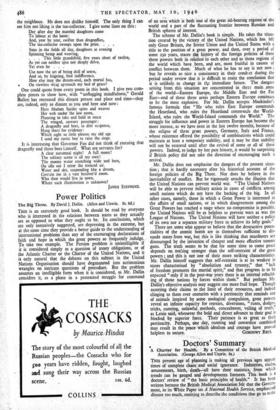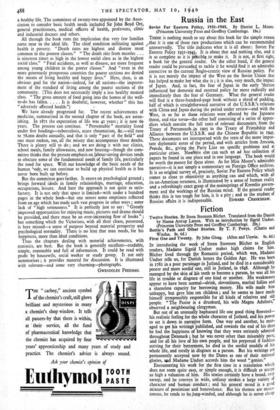Doctors' Summary
A Charter for Health. By a Committee of the British Medical Association. (George Allen and Unwin. 6s.)
'nits present age of planning is making all previous ages appear times of complete chaos and social ignorance. Industries, trades, amusements, birth, deathr—all have their statistics, from which trends can be gauged and developments foreseen. This book is doctors' review of " the basic principles of health." It has been written because the British Medical Association felt that the Govern- ment, in its White Paper on A National Health Service, emphasised disease too much, omitting to describe the conditions that go to make
a healthy life. The committee of twenty-two appointed by the Asso- ciation to consider basic health needs included Sir John Boyd Orr, general practitioners, medical officers of health, professors, clime and industrial doctors and others.
All through the book runs the implication that very few families come near to the ideal life. The chief condition militating against health is poverty. " Death rates are highest and disease most common in the poorest classes." " The death rate from measles . . . is nineteen times as high in the lowest social class as in the highest social class." " Fatal accidents, as well as disease, are more frequent among young children in the poorer classes." And " even in the more generously prosperous countries the poorer sections are denied the means of living healthy and happy lives." Here, then, is an obvious goal for the nation—indeed, for all nations—the improve- ment of the standard of living among the poorer sections of the community. (This does not necessarily imply a less healthy monied class. " The gross amount of food going into the homes of the well- to-do has fallen It is doubtful, however, whether" this has " adversely affected health.") We have already progressed far. The recent achievements of medicine, summarised in the second chapter of the book, are aston- ishing. In 1871 the expectation of life was 41 years ; it is now 6o years. The process can continue. " Preventable " mortality listed under five headings—tuberculosis, acute rheumatism, &c.—still runs to 78,000 deaths annually, and that is only " part of the field " and one must reckon, too, all the misery that accompanies those deaths. There is plenty still to do ; and we are doing it with our clinics, school meals, family allowances, and new housing—though the com- mittee thinks that the present emphasis on labour-saving devices tends to obscure some of the fundamental needs of family life, particularly the need for space. With our knowledge of the basic needs of the human ''ody, we can continue to build up physical health as it has never been built up before.
But the committee goes farther. It enters on psychological ground ; brings forward ideals in family relationships, marriage, education, occupations, leisure. And here the approach is not quite as satis- factory. It is not only that space is limited—with under a hundred pages in the whole book—but one senses some emptiness reflected from an age which has made such vast progress in other ways ; some lack of " high seriousness." It is perfectly just to say: " Greatly improved opportunities for enjoying music, pictures and drama should be provided, and there must be an ever-increasing flow of books " ; but something which the Victorians, with all their chaos, possessed, is here missed—a sense of purpose beyond material prosperity and psychological normality. There is no hint that man needs, for his happiness, more than kleal conditions.
Thus the chapters dealing with material achievements, with statistics, are best. But the book is generally excellent—readable, simple, reasonable and full of information. It could be read with profit by housewife, social worker or study group. It not only summarises ; it provides material for discussion. It is illustrated with relevant—and some very charming—photographs.
GWENDOLEN FREEMAN.



























 Previous page
Previous page